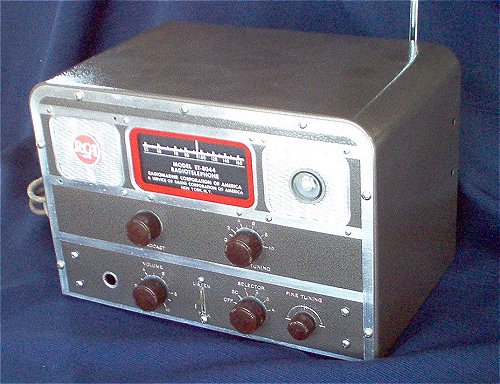 RCA Radiomarine marine radiotelephone, model ET-8044. No well equipped yacht would be without one of these, which allowed state of the art communication with other boats and ships, and even allowed the placing of telephone calls while coastal cruising. Click on the image to see the restoration page. |
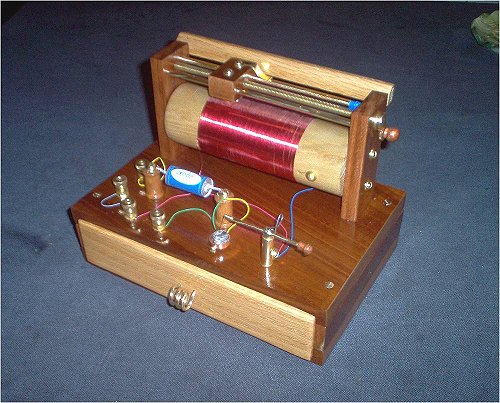 Here is a crystal radio I built. The antenna coil is tuned with a sliding contact, which is mounted on a wooden block riding on two brass rods, which is driven by a screw. I combined several plans and suggestions to come up with this radio, including a homemade tin-foil and wax paper capacitor. It uses no power other than that received by the antenna, and powers a crystal earphone. The drawer stores the earphone, spare whiskers, and an antenna and ground stake for "portable" use. Click on the image for pictures more info and pics. |
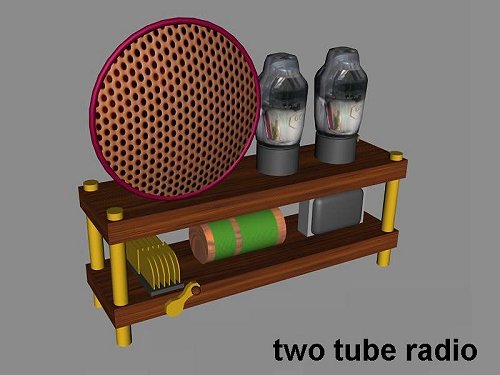 Here is a CAD illustration of a radio I designed last year, and for which I have collected most of the parts. I did not design the circuit, just the arrangement. It is a two tube, 6v radio. The variable cap is one of my own design, a linear one I originally thought up for the crystal radio, above. I haven't made one yet, but it should work. The plates of the cap would be meshed by turning the crank seen below it. The screw would be in a hole bored in the wooden chassis bottom, and move the variable plate set via a slot. The screw would drive a nut soldered on the bottom of the plate set. The chassis shelves will be mahogany, the speaker grill, copper. The tubes, speaker, and transformer are all off the shelf (out of the wrecked radio?) items. It's a "who knows when?" project. |
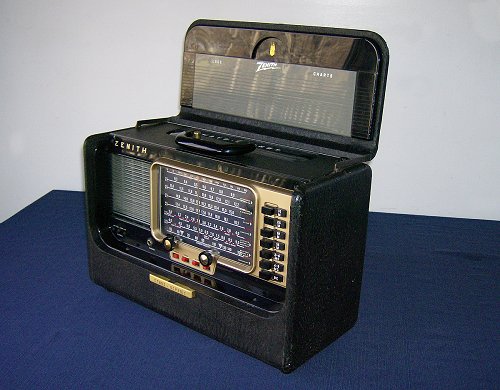 1959
Zenith Trans-Oceanic model B600. The ultimate tube portable
shortwave receiver, in my opinion. I was lucky to find this almost
flawless example, with un-marred covering, no cracked plastic, original
tubes. It has the original manual, and even the original sales brochure
with the string to hang it on the antenna in the showroom. 1959
Zenith Trans-Oceanic model B600. The ultimate tube portable
shortwave receiver, in my opinion. I was lucky to find this almost
flawless example, with un-marred covering, no cracked plastic, original
tubes. It has the original manual, and even the original sales brochure
with the string to hang it on the antenna in the showroom.The model before this one (H500) used the same panel molding, without the rectangular hole for the dial light switch. But the H500 had a rotating dial like the older models, and filled the area to the right of the dial markings with decoration. It seems to me that this was a transitional unit... they had the molding for the B600's later panel, but had not worked out the "slide rule" tuning mechanism. I have not seen this possibility referred to anywhere, and wondered if anyone shared that opinion. With it's own antenna, conditions right, I have clearly picked up most of the world... RCI in China, Romania, BBC for North America, but also BBC Africa, Middle East, Taiwan. When hooked up to a 100' long wire antenna, I can receive amateurs from Canada to Maryland, and as far west as Indiana. The sound of this radio is extraordinary... mellow and rich... due to it's wooden cabinet no doubt. Click image for larger, 1200x view. |
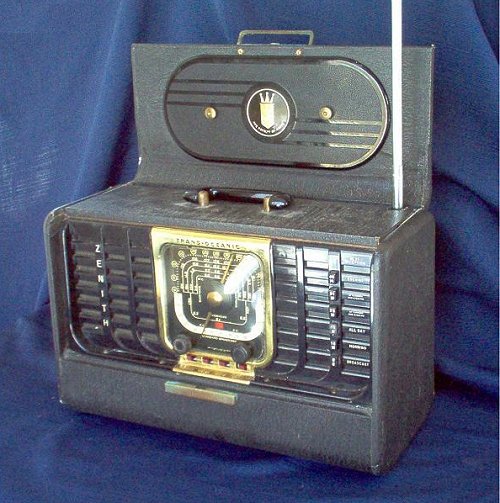 Zenith Trans-Oceanic model G500. This is the least common TO model, at approximately 18,000 produced. It has a handsome brass badge on the antenna, and a unique cabinet shape and handle casting. This is a future restoration project. It is complete and intact. Mostly the unit could stand a good cleaning, and the plastic needs polishing. There is some corrosion on the brass, too. But the covering is unworn, and has no tears. I may be able to avoid the recommended shoe polish treatment. I replaced all the capacitors with modern mylar caps. I just recently (2006) got this radio to work. I found that the double 950 ohm power resistor had failed. By replacing both with 1k, 22 watt wirewounds, the radio now works fine. Amazingly sensitive and selective, I have easily and clearly picked up Asia and Europe, along with the BBC, Cuba and so on. It has quickly become one of my favorite user radios. Interestingly, I am only the second owner of this unit! It was sold by the original owner's son, for him, directly to me. |
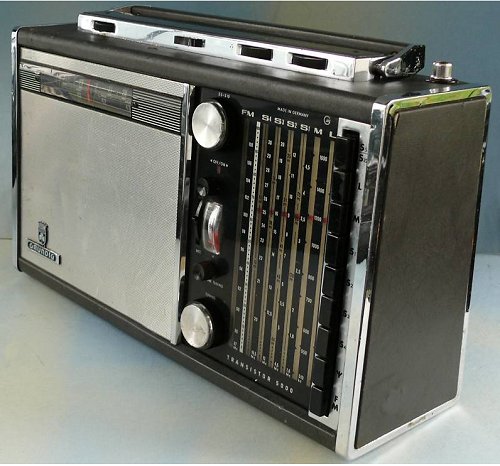
Grundig Satellit 5000: I just won this on eBay for the unbelievable price of only $20.51. Well I suppose it is actually somewhat believable, because the covering has a couple of small tears in it, the dial cord is broken, and the tip of the antenna is missing! But I wanted one of these for some time... and the usual going rate of $250 to $400 was a bit of an obstacle. Fixing the dial cord is no problem, and I think I have a pretty close approximation of the antenna parts in my extras. The covering will be a problem... if I decide to recover it, I doubt I will find a perfect match. I may just carefully glue down the tears and get them as close as I can. Some of the things I like about this radio, besides being the first Satellit, are that it has ten bands, and two of the shortwave bands are on a separate turret tuner (seen to the left). This is to provide adequate bandwith for selective tuning. Then, it also has FM... up to 108mhz, as this was for the American market (the 205 was the European designation). The sound is very good, too, as it has a wooden case, and comes with a nice sized speaker, and a woofer and tweeter. So what I have is a top quality 45 year old radio, which is not so nice it has to sit on a shelf, so that I can actually use and enjoy it... I will be able to sit outside, or take it on a trip, and catch any frequency I'm interested in. I also wired it so that I can play my MP3 player through the audio amp. Life is now complete. For more pictures of the radio, with inside shots, and some of the re-stringing, click on the image to the left, or here. 1964/66, UKW (FM) 87-108 MHz, LW 145-350 kHz, MW 510-1620 kHz, SW1 1,6-4,8 MHz, SW2 4.5 - 12,3 MHz, SW3 12-20 MHz, SW4 19.5-30MHz, 16m, 19m, 25m, 31m, 41m, 49m SW, runs on 4 "D" cells. |
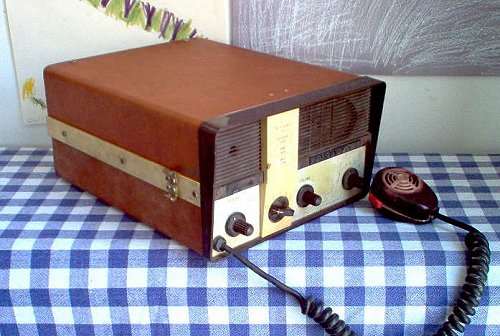 This Simpson 45 is actually much more
impressive in person than in the picture. The aluminum cabinet has a
unique plastic texture bonded to the surface... and it is a very good
imitation of top-grain cowhide. The radio came with crystals for 2182
(call & distress), 2638 & 2738 (ship to ship), and 2406...
which is labeled "Boston". It also receives on AM broadcast. The radio
seems to operate perfectly, much to my surprise. AM is clear and
sensitive. The chassis and components are the nicest I've seen, and
meticulously assembled. This Simpson 45 is actually much more
impressive in person than in the picture. The aluminum cabinet has a
unique plastic texture bonded to the surface... and it is a very good
imitation of top-grain cowhide. The radio came with crystals for 2182
(call & distress), 2638 & 2738 (ship to ship), and 2406...
which is labeled "Boston". It also receives on AM broadcast. The radio
seems to operate perfectly, much to my surprise. AM is clear and
sensitive. The chassis and components are the nicest I've seen, and
meticulously assembled.This unit will only need a good cleaning, polishing of the plastic, and new gold leaf on the raised lettering. My guess is that it dates from about 1957 to 1962... but so far, this is only from the technology and design. |
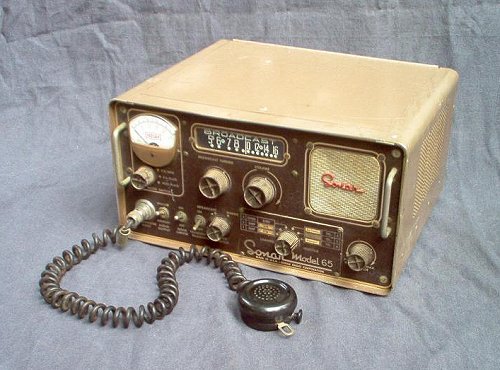 Sonar
Model 65 Radiotelephone. This
unit is in working order as I got it. It is a 12 volt tube radio, with
six crystal controlled transmit frequencies, and six receive crystals.
The radio came out of a yacht in Texas, the White Dove. Sonar
Model 65 Radiotelephone. This
unit is in working order as I got it. It is a 12 volt tube radio, with
six crystal controlled transmit frequencies, and six receive crystals.
The radio came out of a yacht in Texas, the White Dove.The Sonars are just magnificent radios. Solidly built for rough use. They are beautifully and practically designed, too. A large panel on the top of this one can be opened with a quarter twist of one screw. This give fast access to crystals for changing out, or for service. I believe this radio would date from about 1948 to 1954. Compare it's design to two Sonar RDF's on the "sister" page. |
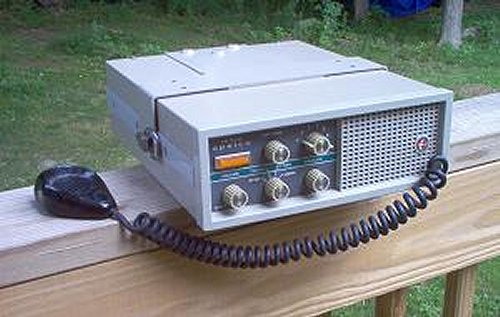 Apelco
Model 101W. A transistor/tube hybrid from the late 60's to mid 70's (I
think). The unit is in almost new condition, perfectly clean, and seems
to work flawlessly. The "getting" of this unit is the most interesting
part... the sellers told me on three occasions they sent it out, the
last two times admitting they had not. They kept sending me money each
time there was a glitch... I think it came to $8 in refunds. Since the
radio cost only $4.99, and $7 shipping, I think it cost me a total of
$4 for the radio and shipping. It was all very strange. Apelco
Model 101W. A transistor/tube hybrid from the late 60's to mid 70's (I
think). The unit is in almost new condition, perfectly clean, and seems
to work flawlessly. The "getting" of this unit is the most interesting
part... the sellers told me on three occasions they sent it out, the
last two times admitting they had not. They kept sending me money each
time there was a glitch... I think it came to $8 in refunds. Since the
radio cost only $4.99, and $7 shipping, I think it cost me a total of
$4 for the radio and shipping. It was all very strange.This would be the perfect unit to set up as a ham transmitter. Having it has convinced me I should get my license, if for no other reason than to try some transmitting on it. |
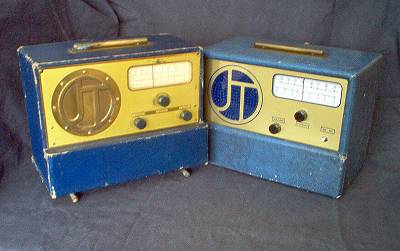 Two Jefferson-Travis Marine
Receivers. On the left is a model M-2b, on the right a model M-3. Both
receive broadcast and 1.6 to 4.6/4.8 MC, the old marine
band. There is an interesting evolution in these two radios. The first,
on the left, has a heavy brass face, and a nice brass speaker screen.
There is a heavy brass carrying handle, and two matching feet. The
case's "stepped" design is evocative of the Zenith Transoceanic's...
but without the TO's cover. It is A/B battery only. Two Jefferson-Travis Marine
Receivers. On the left is a model M-2b, on the right a model M-3. Both
receive broadcast and 1.6 to 4.6/4.8 MC, the old marine
band. There is an interesting evolution in these two radios. The first,
on the left, has a heavy brass face, and a nice brass speaker screen.
There is a heavy brass carrying handle, and two matching feet. The
case's "stepped" design is evocative of the Zenith Transoceanic's...
but without the TO's cover. It is A/B battery only.The second radio was made after Emerson bought JT, as the Emerson name was added to the dial face. I can just picture the bean counters at Emerson making some decisions to increase both the market and profit margin of this radio. For one thing, they added a 115 vac power option, immediately increasing the market. They omitted the brass feet, substituting rubber button feet. Most notably, the nice brass face and speaker screen were replaced by a single silk screened plastic face, with speaker holes punched out. The fact that this face was clipped in from the back, and the speaker no longer needed eight (!) screws, must have greatly simplified and speeded assembly. These steps did not save the Jefferson-Travis name, I don't think. JT lasted into the 1950's as a label on various transistor radio imports, then disappeared by the early 60's. I think radios of this type were intended for use by boaters, fisherman or beach-goers along the coast. With the marine band feature, coastal weather broadcasts, ship to ship, ship to shore and marine radiotelephone signals could all be monitored. They would have been the perfect small boat or summer beach cottage entertainment and information system. The radio on the left had a bad 3Q5 tube. When I replaced it, and hooked up my homemade A/B battery, it worked fine. It's interesting how even the least fancy tube broadcast radios of this era sound so nice. I was also able to clearly pick up an amateur on the 75 meter band... not sure how far off they were, though. I also recently go the M3 to work by replacing one tube. I sold the radio on the right. |
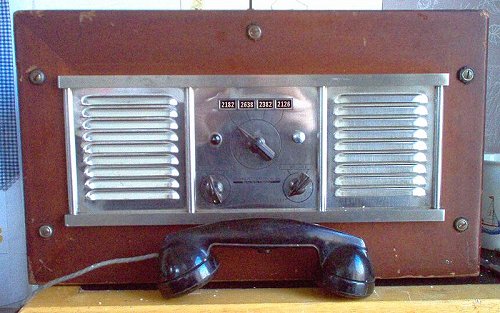 Ray-Jefferson Model 410 Marine Radiotelephone. Ship/Ship, Ship/Shore, Emergency and Land Telephone... no Broadcast band. When I bought this ($9.99 on eBay) I had no idea how HUGE it was. This is a really high end unit... the stainless face is bounded by solid stainless bars top and bottom. They are 5/8" x 1/4". The whole front is solid Honduoras Mahogany. In place of a vibrator, the high voltage transmit current is produced by a dynamotor. All wires are run like a NASA probe. I think this radio was intended for a luxury market, and possibly a specific yacht... maybe a Hatteras or Matthews... or perhaps a sailing yacht. Click on the picture for more shots, including the interior. |
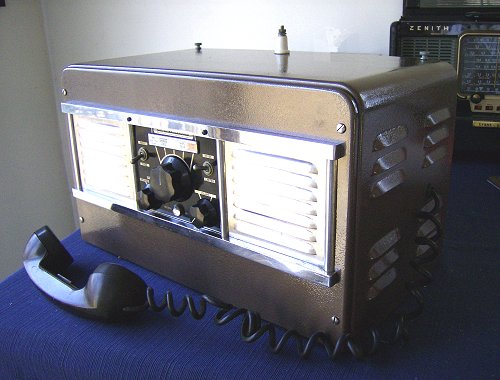 1959
Ray
Jefferson model 635 Transceiver. This is also a truly
massive piece of machinery, very similar to it's 10 year older sister,
above. And they they do qualify as machinery due to the
dynamotor... it looks like it could start a V-12 Cadillac. The front
panel alone, with the solid stainless bars and grills, is heavier than
my entire modern VHF marine transceiver! They did not jump
on the styling craze of the late 50's, it seems.
The outside design did not change in over ten years! The works kept up
inside, however. 1959
Ray
Jefferson model 635 Transceiver. This is also a truly
massive piece of machinery, very similar to it's 10 year older sister,
above. And they they do qualify as machinery due to the
dynamotor... it looks like it could start a V-12 Cadillac. The front
panel alone, with the solid stainless bars and grills, is heavier than
my entire modern VHF marine transceiver! They did not jump
on the styling craze of the late 50's, it seems.
The outside design did not change in over ten years! The works kept up
inside, however. The radio was dirty, rusty and with stiff controls when I got it. I've cleaned it up, and repainted it with a very close hammertone brown. I fired it up (6V battery charger), and the dynamotor wound up like a B-52. It wants to work, and transmits static when I key it... but cuts out when I speak into the mic. Overload? I got this one for $9.95. I'm starting to think I'm the only nut who collects these old monsters. I suppose it's the "obsolete" part which turns people off! Click on image for dedicated page. |
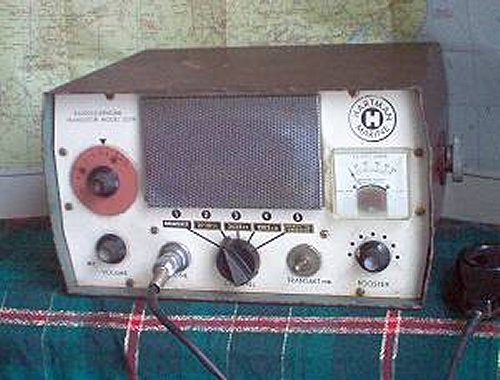 Hartman Model 3056. This was either a kit (most likely) or a prototype, as the chassis is has hand pencilled notations for all components. These markings are in places clearly inaccessible once the unit was assembled. This uses transistors and a couple of tubes. It looks to be from the very late 50's through the early 60's. Although a quality unit, it utilizes mostly off-the-shelf components. The simple case, silk screening, speaker grill, along with the disparate and inappropriate (from a design standpoint) knobs and meter leads me to believe this was a very small company. I've found no information on the firm. Radio does not fire up. |
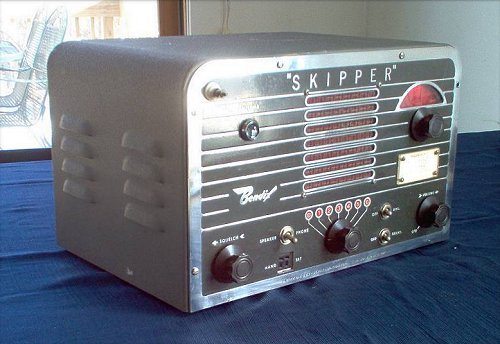 Bendix
Skipper. This is a 12volt, negative ground radiotelephone. I'm
guessing from the late 40's to early 50's. It has the same level of
technology as the Radiomarine ET-8044 at the top of this page. Bendix
Skipper. This is a 12volt, negative ground radiotelephone. I'm
guessing from the late 40's to early 50's. It has the same level of
technology as the Radiomarine ET-8044 at the top of this page.Receives and transmits on a maximum 6 crystal controlled marine bands, and receives on regular broadcast band. This is tuned with a handsome red backlit circular dial. The "pilot" for transmit... marked "antenna", is a small neon bulb behind a thick clear glass lens. This would be excited by the actual transmission signal and glow. Interestingly, the antenna is attached to the FRONT of the unit, with a neat little ceramic insulator stand-off. The speaker cloth I can't figure out... it is woven, but stiff. It may be woven from plastic, or even plastic coated wire. It is a very colorful weave of a type I've never seen on a radio. This radio, as I found it (.99 cents on ebay), was missing the hand/headset, and the volume pot. The missing pot will cause a problem as all six wires were cut... in order to fire up the unit, lacking a schematic, will take some careful investigation of the circuit. I feel the look of this unit is a perfect example of "engineer designing". No Raymond Loewy here, this was probably designed by the same engineers who designed the circuit and chassis. Radio development was evolving so rapidly before, during and after the war, and through the 50's, that what was "right" for the look of a piece of marine electronics changed rapidly, too. I love the look of this radio. |
But this is a jewel. Solid, brushed and polished stainless-steel face! It is very similar to the Bendix Skipper, above, but is much smaller. This, because it is apparantly less powerful (not sure, but probably a 20 watt unit), and only has two crystals. They are gone, but the buyer would probably have made one 2182 for Coast Guard, hailing, and emergency. Then the other would have been either ship-to-ship, like 2638, or a local telephone station... if the owner wanted it to make land-line phone calls. The grill, like the above Bendix, seems to be a weave of plastic covered wire, with an attractive weave pattern... in blue, and brown. Just a very pretty radio. Now to find an appropriate mic. |
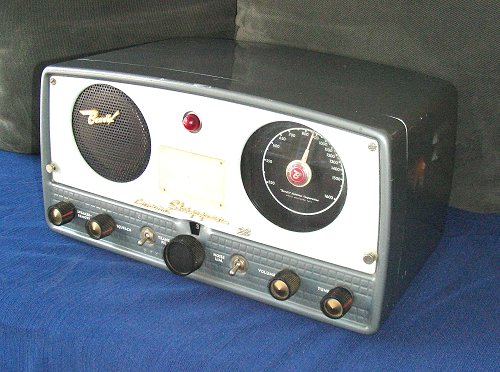 Bendix Skipper
Custom 28. 7 crystals for reeeive/transmit, plus broadcast band for
listening. Bendix Skipper
Custom 28. 7 crystals for reeeive/transmit, plus broadcast band for
listening.This unit, and it's "sister" direction finder unit, the model 440, are break from much of the post-war tendency to use "industrial design". Much effort, and probably cost, was put into the design and construction of these radios. The case is an elaborate melding of graceful curves, all the way around the back. The front panel is tilted forward. The whole look of this radio is evocative of a '50's exotic sports car, and it would not look out of place in the finest Italian motor yacht. And I suppose that was the point. This is the only one of these I have ever seen... I lost it to another bidder, who put it up for sale two weeks later... and I won it. Ebay is always a wild ride. |
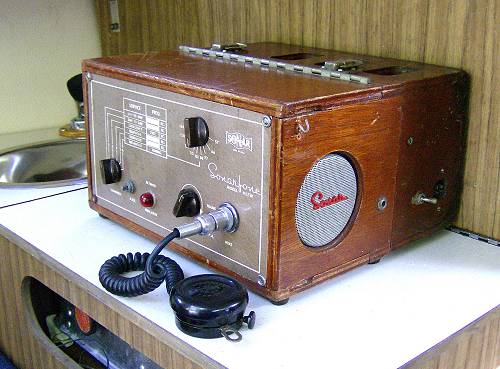 Sonar Radio model M35W Sonarfone. This has an interesting feature I had not seen on a ship radio: The 2182 KC emergency frequency is built in, rather than being a replaceable crystal... or an option. This makes perfect sense, but until I saw it it never occurred to me. Including 2182, it has slots for four more crystals, and a complete BC range from "57" to "164". Weird. Why to 1640 KC, and not just the usual 1600? And what's with 570 KC? A fine post war marine radiotelephone. |
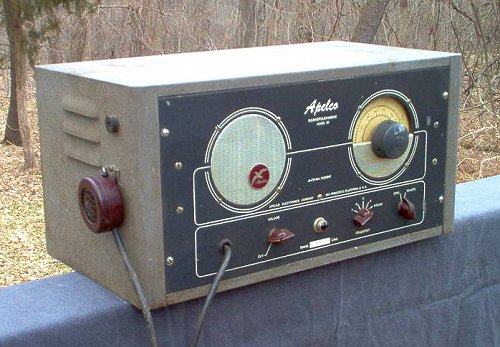 Apelco Model 30 Radiotelephone. Not
sure of the year, as I can find no information on this. It uses a
combination of octal and miniature tubes. I think it may be from the
early to mid-50's. An interesting feature is a continuously tunable
marine band for reception. Most of these radios use crystals for both
receive and transmit. The easy to use, geared tuner knob would make it
very easy for the listener to manually scan all marine frequencies for
communications and information. When I see the feature here, and on
other "receive only" sets, I wonder why it was not used on all
radiotelephones. Maybe it is a base station? This feature makes is
usable as a ham receiver... although I have not powered it up. Apelco Model 30 Radiotelephone. Not
sure of the year, as I can find no information on this. It uses a
combination of octal and miniature tubes. I think it may be from the
early to mid-50's. An interesting feature is a continuously tunable
marine band for reception. Most of these radios use crystals for both
receive and transmit. The easy to use, geared tuner knob would make it
very easy for the listener to manually scan all marine frequencies for
communications and information. When I see the feature here, and on
other "receive only" sets, I wonder why it was not used on all
radiotelephones. Maybe it is a base station? This feature makes is
usable as a ham receiver... although I have not powered it up.There is broadcast reception in addition to the 2.0 to 6.0 mhz marine band. It is just a HUGE unit at 20" wide by 10" high. Not for your day sailor. This cost only 99 cents on ebay... we won't talk about the postage, though. |
Raytheon 1055A Transceiver, 6 crystals and BC. This radio works fine, but was in bad shape when I got it almost two years ago. Another beauty, though, with the aquamarine plastic grill, and matching cord, set off by the bright red logo. This picture... the original eBay picture... does not do it justice. When I get around to cleaning and fixing it up I'll take a better one. Radio works fine. You could hook this up to a 12v power supply, and use it to listen to AM talk radio all day. |
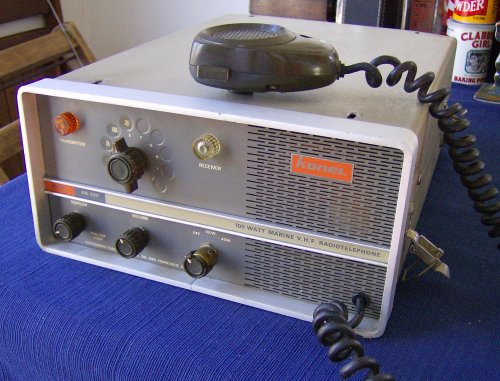 Konel KR-33V VHF Marine Radiotelephone. This has dial position marked with the channel numbers 6, 16, 17a, 18a, and 26. These are modern VHF channel designations, and 16, of course, is emergency channel. I have managed to get it to transmit on 16, but it has not tranmsitted or received on the other frequencies. I'm going to try another antenna... it probably works fine. So in effect, I have a classic, early VHF marine radio which I could mount this in one of my boats, go out on the Hudson, and use. |
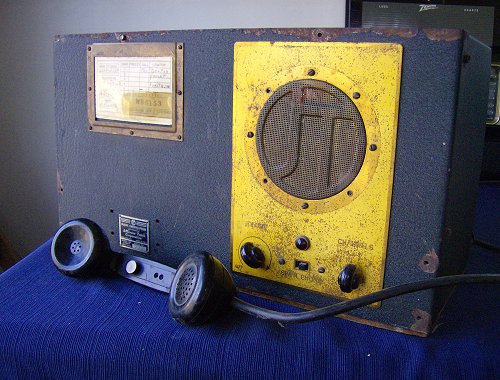 Jefferson-Travis
Model 102. 10 watts, 6-12 volts. I think this radio is from the late
1930's, possibly 1938-41. It has the most beautiful brass face-plate,
with both frosted and polished surfaces. This is the same approach as
used in their M2-B, shown above. Jefferson-Travis
Model 102. 10 watts, 6-12 volts. I think this radio is from the late
1930's, possibly 1938-41. It has the most beautiful brass face-plate,
with both frosted and polished surfaces. This is the same approach as
used in their M2-B, shown above.The paper label with yacht name and call letters is still intact! The owner was an A.F. Land, the yacht was the Star-Dust out of Boston. I found reference to a 1939 wooden 32' sailing yacht in Connecticut, and I plan to contact the owner in the event it is the same boat. The odds are slim, however, as there must have been hundreds of wooden "Star-Dust"s over the years, all long gone. The odds of both the orginal radio, and original boat both surviving are fairly slim, I think. The only part this is missing is the speaker, from what I can see. It even has the original art-deco knobs. I have to decide what sort of refinishing, if any, I will do to this. I think I may just give it a good cleaning, and otherwise leave it alone. MORE PICS HERE. |
 |